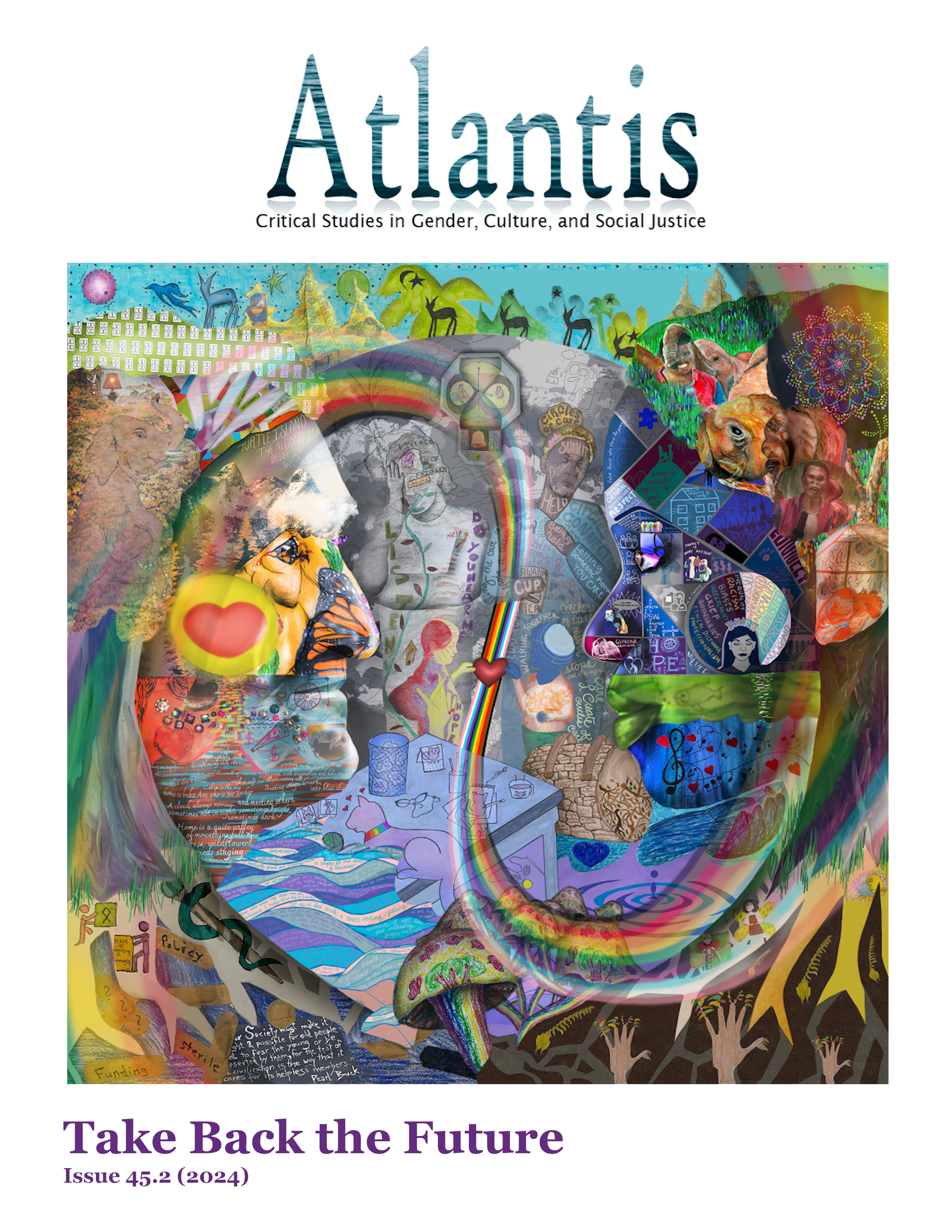Body Modification as Body Art
Aging, Abjection, and Autothanatology
Keywords:
abject, aging, ageism, anti-aging, body art, body modification, feminist art, immanence, thanatology, transcendenceAbstract
In this article, I discuss my “anti-aging” body modification practices as body art. The art documents my bodybuilding programs, self-administered neurotoxin (Botox) injections, and skin resurfacing treatments. Susan Pickard (2020) argues that femininity and aging are associated with the abject. She maps the abject and non-abject onto Simone de Beauvoir’s distinction between immanence and transcendence. Because “abjection should always be understood as an element of [...] oppression” (Pickard 2020, 159), my art practice could be read as an anti-feminist, ageist attempt to expel the abject. After offering a counter-argument that positions my practice as feminist, I use Kathy Acker’s (1993) writing on bodybuilding to offer a third reading. Muscles grow when they are worked until failure. This practice of constantly coming up against the body’s limits is a rehearsal for the ultimate failure of the body: death (Acker 1993). If thanatology is the study of death and dying, bodybuilding is autothanatology. My “anti-aging” interventions are similar; they are inevitable failures that cannot stop the aging process. In this way, my practice is a reminder that the body exists in a state of immanence, even while I may attempt to frame my immanence along transcendental terms.
References
Acker, Kathy. 1993. “Against Ordinary Language: The Language of the Body.” In The Last Sex: Feminism and Outlaw Bodies, edited by A. Kroker and M. Kroker, 20-27. Montreal: New World Perspectives.
Art Story, The. 2022. “ORLAN.” https://www.theartstory.org/artist/orlan/
Arya, Rina. 2014. “Taking Apart the Body: Abjection and Body Art.” Performance Research 19(1): 5-14.
Beauvoir, Simone de. 1953. The Second Sex. Trans. H. Parshley. London: Jonathan Cape.
Bell, Shannon. 2010. Fast Feminism. New York: Autonomedia.
_____. 2012. “Nina Arsenault: Fast Feminist Objet a.” In Trans(per)forming Nina Arsenault: An Unreasonable Body of Work, edited by J. Rudakoff, 3-13. Bristol: Intellect.
Bordo, Susan. 1989. “The Body and the Reproduction of Femininity: A Feminist Appropriation of Foucault.” In Gender / Body / Knowledge: Feminist Reconstructions of Being and Knowing, edited by A. M. Jaggar and S. R. Bordo, 13-33. New Brunswick: Rutgers University Press.
Butler, Judith. 1988. “Performative Acts and Gender Constitution: An Essay in Phenomenology and Feminist Theory.” Theatre Journal 40(4): 519-531.
_____. 1997. The Psychic Life of Power: Theories in Subjection. Stanford: Stanford University Press.
Cesarano, Francesca. 2022. “Beyond Choice: A Non-Ideal Feminist Approach to Body Modification.” Res Publica 2023(29): 647-663.
Do Rozario, Rebecca-Anne C. and Deb Waterhouse-Watson,. 2014. “Beyond Wicked Witches and Fairy Godparents: Ageing and Gender in Children’s Fantasy on Screen.” In Ageing, Popular Culture, and Contemporary Feminism, edited by I. Whelehan and J. Gwynne, 233-247. New York: Palgrave Macmillan.
Dworkin, Andrea. 1974. Women Hating. New York: Plume.
Edstrom, Maria. 2018. “Visibility Patterns of Gendered Ageism is the Media Buzz: A Study of the Representation of Gender and Age Over Three Decades.” Feminist Media Studies 18(1): 77-93.
Edwards, Phil. 2015. “How the Beauty Industry Convinced Women to Shave their Legs.” Vox, May 22.
Elnahla, Nada. 2015. “Aging with Disney and the Gendering of Evil.” Journal of Literature and Art Studies 5(2): 114-127.
Erickson, Loree. 2014. “Out of Line: The Sexy Femmegimp Politics of Flaunting It!” In Sex Matters: The Sexuality and Society Reader (5th Ed), edited by M. Stombler et al., 153-158. New York: W. W. Norton and Company.
Gill, Rosalind. 2007. “Postfeminist Media Culture: Elements of a Sensibility.” European Journal of Cultural Studies 10(2): 147-166.
Jones, Amelia. 1998. Body Art: Performing the Subject. Minneapolis: University of Minnesota Press.
Kristeva, Julia. 1982. Powers of Horror: An Essay on Abjection. Trans. L. Roudiez. New York: Columbia University Press.
Luscombe, Belinda. 2023. “Madonna’s Face and the Myth of Aging Gracefully.” Time Magazine, February 9. Accessed June 12 2023.
Madonna. 2023. “Sam Smith, Kim Petras, Unholy.” Instagram, February 07. Accessed July 10 2023. https://www.instagram.com/p/CoYOdzSA5mj/?hl=en
Meagher, Michelle. 2014. “Against the Invisibility of Old Age: Cindy Sherman, Suzy Lake, and Martha Wilson.” Feminist Studies 40(1): 101-143.
Pickard, Susan. 2020. “On Becoming A Hag:Gender, Aging and Abjection.” Feminist Theory 21(2): 157-173.
Pitts, Victoria L. 2003. In the Flesh: The Cultural Politics of Body Modification. New York: Palgrave Macmillan.
Rudakoff, Judith. 2012. “Introduction.” In Trans(per)forming Nina Arsenault: An Unreasonable Body of Work, edited by J. Rudakoff, 3-13. Bristol: Intellect.
Serano, Julia. 2007. Whipping Girl: A Transsexual Woman on Sexism and the Scapegoating of Femininity. New York: Seal Press.
Van den Bulck, Hilde. 2014. “Growing Old in Celebrity Culture.” In Aging, Media, and Culture, edited by C. L. Harrington et al., 65-76. Lanham: Lexington Books.
White, Zaren Healey. 2016. “‘I Am Not My Bodies’: Transgender Embodiment in Nina Arsenault’s The Silicone Diaries.” Atlantis: Critical Studies in Gender, Culture, and Social Justice 37(2): 173-183.
Downloads
Published
Issue
Section
License
Copyright (c) 2024 Jessica Joy Cameron

This work is licensed under a Creative Commons Attribution 4.0 International License.
Authors who publish with this journal agree to the following terms:
1. Authors retain copyright and grant the journal right of first publication, with the work simultaneously licensed under a Creative Commons Attribution 4.0 International License that allows others to share the work with an acknowledgement of the work's authorship and initial publication in this journal.
2. Authors are aware that articles published in Atlantis are indexed and made available through various scholarly and professional search tools, including but not limited to Erudit.
3. Authors are able to enter into separate, additional contractual arrangements for the non-exclusive distribution of the journal's published version of the work (e.g., post it to an institutional repository or publish it in a book), with an acknowledgement of its initial publication in this journal.
4. Authors are permitted and encouraged to preprint their work, that is, post their work online (e.g., in institutional repositories or on their website) prior to and during the submission process. This can lead to productive exchanges, as well as earlier and greater citation of published work. Read more on preprints here.







